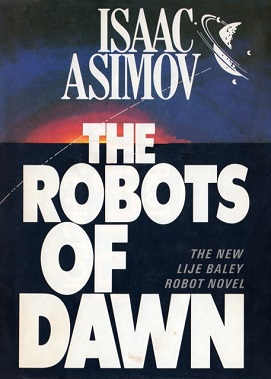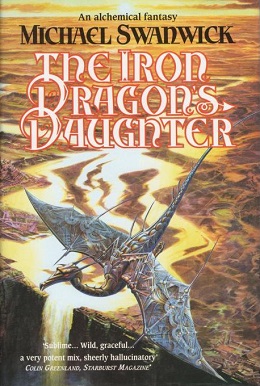Related Research Articles

Alfred Elton van Vogt was a Canadian-born American science fiction author. His fragmented, bizarre narrative style influenced later science fiction writers, notably Philip K. Dick. He was one of the most popular and influential practitioners of science fiction in the mid-twentieth century, the genre's so-called Golden Age, and one of the most complex. The Science Fiction Writers of America named him their 14th Grand Master in 1995.

I, Robot is a fixup collection made up of science fiction short stories by American writer Isaac Asimov. The stories originally appeared in the American magazines Super Science Stories and Astounding Science Fiction between 1940 and 1950 and were then collected into a 1950 publication Gnome Press in 1950, in an initial edition of 5,000 copies.

Isaac Asimov was an American writer and professor of biochemistry at Boston University. During his lifetime, Asimov was considered one of the "Big Three" science fiction writers, along with Robert A. Heinlein and Arthur C. Clarke. A prolific writer, he wrote or edited more than 500 books. He also wrote an estimated 90,000 letters and postcards. Best known for his hard science fiction, Asimov also wrote mysteries and fantasy, as well as popular science and other non-fiction.

Mars, the fourth planet from the Sun, has appeared as a setting in works of fiction since at least the mid-1600s. Trends in the planet's portrayal have largely been influenced by advances in planetary science. It became the most popular celestial object in fiction in the late 1800s, when it became clear that there was no life on the Moon. The predominant genre depicting Mars at the time was utopian fiction. Around the same time, the mistaken belief that there are canals on Mars emerged and made its way into fiction, popularized by Percival Lowell's speculations of an ancient civilization having constructed them. The War of the Worlds, H. G. Wells's novel about an alien invasion of Earth by sinister Martians, was published in 1897 and went on to have a major influence on the science fiction genre.

Robert Anson Heinlein was an American science fiction author, aeronautical engineer, and naval officer. Sometimes called the "dean of science fiction writers", he was among the first to emphasize scientific accuracy in his fiction, and was thus a pioneer of the subgenre of hard science fiction. His published works, both fiction and non-fiction, express admiration for competence and emphasize the value of critical thinking. His plots often posed provocative situations which challenged conventional social mores. His work continues to have an influence on the science-fiction genre, and on modern culture more generally.

The Robot series is a series of thirty-seven science fiction short stories and six novels created by American writer Isaac Asimov, published from 1940 to 1995. The series is set in a world where sentient positronic robots serve a number of purposes in society. To ensure their loyalty, the Three Laws of Robotics are programmed into these robots, with the intent of preventing them from ever becoming a danger to humanity. Later, Asimov would merge the Robot series with his Foundation series.

The Three Laws of Robotics are a set of rules devised by science fiction author Isaac Asimov, which were to be followed by robots in several of his stories. The rules were introduced in his 1942 short story "Runaround", although similar restrictions had been implied in earlier stories.

Michael Swanwick is an American fantasy and science fiction author who began publishing in the early 1980s.

Asimov's Science Fiction is an American science fiction magazine edited by Sheila Williams and published by Dell Magazines, which is owned by Penny Press. It was launched as a quarterly by Davis Publications in 1977, after obtaining Isaac Asimov's consent for the use of his name. It was originally titled Isaac Asimov's Science Fiction Magazine, and was quickly successful, reaching a circulation of over 100,000 within a year, and switching to monthly publication within a couple of years. George H. Scithers, the first editor, published many new writers who went on to be successful in the genre. Scithers favored traditional stories without sex or obscenity; along with frequent humorous stories, this gave Asimov's a reputation for printing juvenile fiction, despite its success. Asimov was not part of the editorial team, but wrote editorials for the magazine.

The Iron Dragon's Daughter is a 1993 science fantasy novel by American writer Michael Swanwick. The story follows Jane, a changeling girl who slaves at a dragon factory in the world of Faerie, building part-magical, part-cybernetic monsters that are used as jet fighters. The plot of her story takes the form of a spiral, with events and characters constantly recurring in new settings.
Michael Lawson Bishop was an American author. Over five decades and in more than thirty books, he created what has been called a "body of work that stands among the most admired and influential in modern science fiction and fantasy literature."

The literary genre of science fiction is diverse, and its exact definition remains a contested question among both scholars and devotees. This lack of consensus is reflected in debates about the genre's history, particularly over determining its exact origins. There are two broad camps of thought, one that identifies the genre's roots in early fantastical works such as the Sumerian Epic of Gilgamesh. A second approach argues that science fiction only became possible sometime between the 17th and early 19th centuries, following the scientific revolution and major discoveries in astronomy, physics, and mathematics.

Tais Teng is the pen name of a Dutch writer of fantasy fiction, hardboiled detective, children's books, and science fiction. Additionally, Teng works as an illustrator, sculptor, and writing coach. His real name is Thijs van Ebbenhorst Tengbergen, which he had to shorten due to spacing issues on the covers of his books. Other pen names he has used are Eban Hourst and Ben Bergen, which reflect his search for a pseudonym that was pronounceable in languages other than Dutch.

"What Is This Thing Called Love?" is a science fiction short story by American writer Isaac Asimov. The story was requested by Cele Goldsmith Lalli, editor of Amazing Stories, as a satire of an article in Playboy called "Girls of the Slime God" which had suggested that pulp science fiction stories were concerned with aliens and sex. The story appeared in the March 1961 issue of Amazing as "Playboy and the Slime God", but Asimov later retitled it "What Is This Thing Called Love?"
There have been many attempts at defining science fiction. This is a list of definitions that have been offered by authors, editors, critics and fans over the years since science fiction became a genre. Definitions of related terms such as "science fantasy", "speculative fiction", and "fabulation" are included where they are intended as definitions of aspects of science fiction or because they illuminate related definitions—see e.g. Robert Scholes's definitions of "fabulation" and "structural fabulation" below. Some definitions of sub-types of science fiction are included, too; for example see David Ketterer's definition of "philosophically-oriented science fiction". In addition, some definitions are included that define, for example, a science fiction story, rather than science fiction itself, since these also illuminate an underlying definition of science fiction.
"Breeds There a Man...?" is a science fiction short story by American writer Isaac Asimov. It was first published in the June 1951 issue of Astounding and was reprinted in science fiction anthologies such as Beachheads in Space (1952) and The Great SF Stories #13 (1951), as well as in Asimov-only collections such as Through a Glass, Clearly (1967), Nightfall and Other Stories (1969). and Robot Dreams (1986).

The Year's Best Science Fiction: Twenty-Sixth Annual Collection is a science fiction anthology edited by Gardner Dozois that was published on June 23, 2009. It is the 26th in The Year's Best Science Fiction series.
Isaac's Universe is a fictional universe created by Isaac Asimov for other science fiction writers to use as a setting. It introduces the collaborative science fiction universe created by Asimov which eventually resulted in five volumes: three short story collections and two novels. It was initiated by Martin H. Greenberg, who also edited and published its three short stories collection by Avon Books starting in 1990.

Timothy Robert Sullivan, who more commonly uses the name Tim Sullivan, is an American science fiction novelist, screenwriter, actor, film director and short story writer.
Linguistics has an intrinsic connection to science fiction stories given the nature of the genre and its frequent use of alien settings and cultures. As mentioned in Aliens and Linguists: Language Study and Science Fiction by Walter E. Meyers, science fiction is almost always concerned with the idea of communication, such as communication with aliens and machines, or communication using dead languages and evolved languages of the future. Authors at times use linguistics and its theories as a tool for storytelling, as in Jack Vance's Languages of Pao, although technical terms are rarely used, and authors only go into as much detail as the reader will understand.
References
- ↑ "The LOCUS Index to SF Awards". Archived from the original on 2012-06-29. Retrieved 2009-08-24.
- ↑ From Babel’s Fall’n Glory We Fled..., from Asimov’s Science Fiction - February 2008
- ↑ "From Babel's Fall'n Glory We Fled..." , Friday, May 3, 2013
- ↑ “From Babel’s Fall’n Glory We Fled . . .”, one of Swanwick's Blogs at WordPress.com. Posted September 24, 2007)